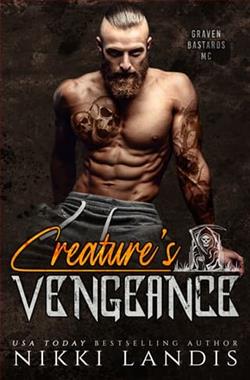Page 13 of American Royals
“I’m sorry, I just … I need a moment alone.” Beatrice felt a bit flustered; she’d never done anything like that before.
But then, the ceremonial trappings of her position had never before felt so stifling.
The various attendants and stylists bobbed quick curtsies before filing out. When they were gone, Beatrice forced herself to look up at her reflection.
The ivory sash was a crisp line against the blue of her gown, catching the cool undertones of her smooth, tanned skin. Various medals and awards glittered in the light, along with her massive pear-shaped earrings and tiered diamond necklace. Her dark hair had been swept into a twist so tight that bobby pins dug angrily into her head. She looked very regal, and slightly older than her twenty-one years.
Well, she probably needed to look mature at tonight’s reception, since she was presumably meeting the man she was going to marry. Whoever he was.
I am Beatrice Georgina Fredericka Louise of the House of Washington, future Queen of America, and I have a duty to uphold. It was the same thing Beatrice always recited to herself, every time she started to feel this sense of panic—as if her life were slipping through her fingers like sand, and no matter how hard she tried to clutch at it, she couldn’t regain control.
A knock sounded on the door to the Brides’ Room. “Ten minutes. You almost ready?”
Relief bloomed in Beatrice’s chest. Here was one person she did want to see. “You can come in, Connor,” she called out.
It would have been inadequate to think of Connor as Beatrice’s bodyguard. Bodyguard failed to encapsulate the honor it was to be a member of the Revere Guard: the years of discipline and brutal training it required, the incredible self-sacrifice. The Guard was far more elite than any group of the armed forces. There were thousands of Marines, and hundreds of Navy SEALs, but the Revere Guard comprised only a few dozen men.
Founded after the assassination of King George II during the War of 1812, the Revere Guard—named for the Revolutionary War hero Paul Revere—answered directly to the Crown. Its men often served the monarch on covert missions abroad, protecting American allies, or rescuing Americans who had been captured. But members of the Guard always rotated home eventually, to serve their original purpose: ensuring the safety of the royal family. It was such a demanding and high-stakes job, with so much travel and uncertainty, that many members of the Revere Guard didn’t settle down or get married until they retired.
“You look nice, Bee,” Connor said, forgoing formality since they were alone. He’d been using that nickname ever since she admitted that it was what Samantha used to call her.
Of course, it had been a long time since Beatrice and her sister were on nickname terms.
She smiled, warmed by his compliment. “You don’t look bad yourself.”
He was wearing the Guards’ dress uniform, a double-breasted navy blazer. It was devoid of any braid or insignia save the traditional gold lantern pin: in memory of the two lanterns of Paul Revere, the warning signal against the British invasion. At Connor’s waist hung a gold ceremonial sword. It might have looked ridiculous and outdated if Beatrice didn’t suspect that he knew precisely how to use it.
Connor had been assigned to her last autumn, at the start of her final year at Harvard. Beatrice would never forget that morning: when Ari, her protection officer for the previous two years, showed up to walk Beatrice to her lecture, accompanied by a tall stranger in a charcoal-colored hoodie. He looked a year or two older than Beatrice.
“Your Royal Highness, this is Connor Markham. He’ll be taking over your security upon my departure tomorrow,” Ari had explained.
Beatrice nodded. She tried not to stare at the young man, but he was hard to look away from, with arresting blue-gray eyes and fair skin. His light brown hair was cut short, emphasizing the strong, clean lines of his face.
Connor inclined his head in a bow so shallow that it bordered on impertinence. The neck of his sweatshirt dipped lower, revealing a line of black ink. A tattoo.
Beatrice found herself wondering about that tattoo, how far it snaked over Connor’s chest, his broad shoulders, his torso. Her face grew hot, and she looked up. Connor met her gaze—and didn’t look away.
His expression was blank, yet Beatrice couldn’t help thinking that Connor had suspected the wayward direction of her thoughts.
She and her new Guard said little to each other, those first couple of months. Not that Beatrice was in the habit of constantly chatting with her security detail. But Connor was especially taciturn, almost … brooding. He never volunteered any information about himself, never made small talk. He was just a tall, silent figure at Beatrice’s side, accompanying her to lectures or to the dining hall, wearing a backpack and a crimson sweater. Unlike most of her security officers, who’d been in their thirties at least, Connor could have passed for a student. Except that by now, everyone on campus was aware of Beatrice’s “incognito” Guards.
Beatrice knew from the beginning that Connor was frustrated with his assignment. Maybe he’d assumed he would be on her father’s detail, in the palace and at the center of the action, instead of babysitting her on a college campus. He was too much of a professional to say anything, but sometimes—when Beatrice was in a study group or grabbing a late-night pizza with friends—she saw the bored amusement tugging at his features. He clearly felt that Guarding her was beneath his capabilities. Well, Beatrice reminded herself, this wasn’t her fault. She certainly hadn’t requested that Connor be here.
One night in November, Beatrice headed to the Boston Museum of Fine Arts, accompanied, as always, by Connor. She was taking an art history class, a requirement for her American Studies major, and the professor had assigned an essay on one of the paintings in this collection. The other students had all come this afternoon, but Beatrice hadn’t wanted to join them. It would have caused such a scene—all those people gawking at her, snapping covert pictures on their phones, whispering and elbowing each other. She felt much more comfortable asking the curator if she could stop by after hours.
Her steps echoed through the empty museum as she searched for the painting. She’d been certain all the Whistler portraits were downstairs, but she didn’t see it. She kept rechecking the room numbers, wishing she hadn’t been in too much of a hurry to pick up a map.
“We need to go upstairs. This hallway only holds art through 1875, and the portrait you’re looking for was done in 1882.”
Beatrice blinked. “You remember that?”
“I was in all the same lectures as you, Princess,” Connor said laconically. That was another annoying habit of his: to call her Princess instead of Your Royal Highness. Beatrice would have corrected him, except that she suspected he wasn’t doing it out of confusion. He was perfectly aware of the protocol, and was trying, subtly, to goad her.
“I thought …” She cut herself off before saying she’d assumed he hadn’t been listening to any of those lectures. But she had been taking notes, and she still didn’t remember the year of that painting off the top of her head.
Connor began to lead her up the stairs. “Eidetic memory is something we worked on in training,” he offered by way of explanation.
Sure enough, he led her straight to the painting she needed: Sir James Whistler’s portrait of Lady Charlotte Eaton, Duchess of Boston.















